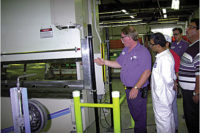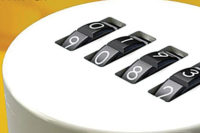"Change is the law of life. And those who look only to the past or present are certain to miss the future.”—John F. Kennedy
Although JFK’s famous quote refers to American society in the early 1960s, it’s just as applicable to American manufacturing in 2013—particularly with regard to safety regulations. In the past two years, industrial safety standards have evolved considerably in response to advances in manufacturing technology. Plant managers who have not been following these developments may find that their facilities are no longer up to code, risking costly fines or worse, injuries to employees.
Ideally, however, forward-thinking companies should do more than just stay up to code. In today’s technologically complex plants, highly trained employees are more valuable than ever. Therefore, safety-minded managers should implement practices that go beyond current regulations to embrace the reality of these highly automated workplaces.
2012 Regulation Overhaul
Some of the biggest regulatory shifts in history have occurred within the past two years. With more and more plant operations becoming automated, the European Committee for Standardization (EN), the International Organization for Standardization (ISO), the Robotics Industry Association (RIA) and other regulatory bodies have revised or overhauled their guidelines and requirements. This started with machine guarding and the move from EN 954-1 to ISO 13849-1 and EN 62061.
ISO 13849-1 provides a clearly defined set of rules to follow when determining requirements for industrial machine control systems. Officially defined as “safety of machinery, safety-related parts of control systems, and general principles for design,” this updated regulation was developed in response to increasingly complex manufacturing processes featuring robotics and other automation technologies. These technologies forced safety control systems and methodologies to keep pace.
ISO 13849-1 is more quantitative, applying common sense and forcing facility managers to validate their safety systems, whereas EN 954-1 was conceptual and only required facilities to apply safety devices (controls) correctly while specifying nonprogrammable, out-of-date technology. Today’s advanced manufacturing processes require more intricate systems to monitor their safe operation and keep machine operators free from harm along the assembly line.
ISO 13849-1 will ultimately make for a much safer manufacturing environment because it accounts for the regulatory gaps that were starting to show in the older standards.
Harmonizing Robotic Safety
Adopted in May 2013, RIA 15.06-2013 brings international and U.S. standards together. This new standard references ISO specifications, which address robots, robot systems and integration. RIA 15.06-2013 was written to be more compliant with international standards already in place in Europe, making life easier for manufacturers, integrators and end users. This new standard will require better hazard identification accounting for not only robot motion, but also the task being performed. It will require validation and verification of safety systems, and it requires designs that incorporate protective measures for both the robot cell and the operator.
Some of the biggest changes in the RIA 15.06 standard have to do with safety-rated motion and the sanctioning of advanced programmable safety devices. Software will now be allowed for “safety-rated” control of various aspects of the robot’s function, limiting the area in which the robot operates and the speed of the robot’s motion. This is a departure from older standards, which did not allow programmable safety controls.
While some regulatory changes have been adopted to keep pace with technological advances, there are a number of plant operations that the new regulations may not address. Currently, these applications default to the Occupational Safety and Health Administration’s General Requirements for all Machines. Specifically, OSHA 29 CFR 1910.212 (a) (3) (ii) states that “the point of operation of machines whose operation exposes an employee to injury shall be guarded.”
The code goes on to state that “in the absence of applicable specific standards, the machine shall be so designed and constructed to prevent the operator from having any part of [his] body in the danger zone during the operating cycle.”
Fortunately, measures can be taken to isolate machine operation with proper guarding devices, such as fixed fencing, automated barrier doors and presence-sensing devices.
Additionally, every operation should at least uphold OSHA’s General Requirements of All Machines. As a basic rule, companies should ensure the safety of their employees. OSHA’s “General Duties Clause” stipulates that each employer:
Shall furnish to each employee a place of employment that is free from recognized hazards that are causing or are likely to cause death or serious physical harm.
Shall comply with occupational safety and health standards.
As with most industrial processes, what once were manual operations are now becoming automated. Most workers are happy to avoid mundane manual tasks. They would rather push a button and allow a machine to take over.
However, some aspects of plant operation have long been overlooked as a hazardous. With manufacturers and warehouses adding more automated functions to their floors—such as material handling with intelligent conveyors, automated guided vehicles and automated storage and retrieval systems—it’s critical that safety methodology is similar to that of other automated processes. They must comply with current OSHA, company and other voluntary standards.
Safety Options
Certainly, presence-sensing devices, such as light curtains and laser scanners, are potential solutions for point-of-interaction safety, whether it’s at a welding station, on the assembly line, or at a stretch wrap machine. However, automated barrier doors may provide a better option. They have many of the same benefits as presence sensors, but with several additional advantages.
Most notably, such doors provide a physical barrier that contains the process while restricting access to dangerous machine movement. This is particularly important for processes in which inertia keeps machinery in motion even after it has been shut down. Additionally, automated barrier doors can be located closer to the process, allowing for a much smaller footprint in the facility.
The most advanced roll-up automated barrier doors can be used in high-speed, high-cycle applications. They also offer hold-down mechanisms and safety-rated noncontact interlock switches and controls. Most automated doors function from the top down, but some have been designed to operate from the ground up. This allows machine operators to easily interact with the process, utilizing overhead cranes to load and unload large, heavy parts. They are also a great option for interaction points that have limited space.
Looking Forward
With new regulations like RIA 15.06 and EN ISO 13849-1 now in place, it is important that facility managers keep up to date on the latest safety technologies to match the right product to the right process. They must consider not only potential machine hazards, but the task being performed. It is also important that they look past the lack of specific safety regulations when making equipment decisions. Instead, they should consider the broader context of OSHA language and guard “the point of operation of machines, whose operation exposes an employee to injury.”
Clearly, automated and robotic operations fall into this category. Given the recent advances in their design and technology, automated barrier doors can be an excellent option to guard many types of machines and protect operators, ultimately increasing productivity and safety for years to come.








